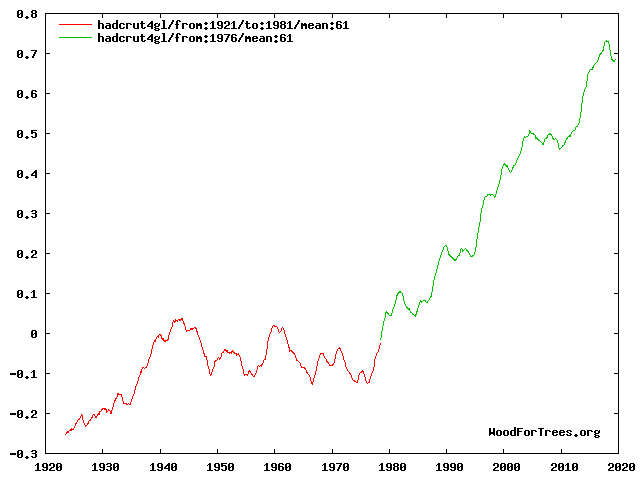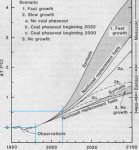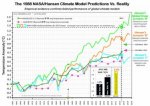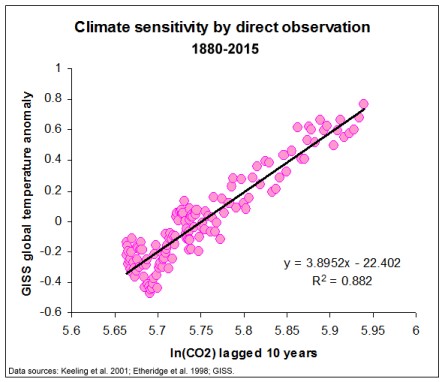- Joined
- Sep 15, 2013
- Messages
- 8,310
- Reaction score
- 4,112
- Location
- Australia
- Gender
- Male
- Political Leaning
- Liberal
...though admittedly not quite as simplistic as all the 'sceptic' assessments I've so far seen :lol:
I'm just going to cobble together a few posts I've made in other threads, mainly because in some recent posts my look at the issue has been even less simplistic than in previous years.
Post #1 will be a brief look at the state of climate modelling in the early 1980s, specifically with reference to Hansen et al 1981;
Post #2 will look briefly at the forecasting of surface temperatures from IPCC Assessment Reports;
Post #3 will glance at hindcasting of surface temperatures by the current CMIP5 crop of models, and
Posts #4 and #5 will have a squiz at the troposphere model/observation comparison popularized by Doctors Christy and Spencer.
It's going to be long, and probably boring and disjointed, but I think there's some worthwhile counter-propaganda here
##
Looking at the state of climate modeling in the early 1980s
A post from May 2014:
Predicting a straight line continuation of the previous trend obviously would not have been the case of a study published in 1981. At the time of publication the 5-year mean of global temperatures which the authors would have been seeing would have looked something like this (red):

Extrapolating from the preceding 35 years' trend would suggest a 0.1 degree decrease in temperatures over the next 35 years.
Instead, based on the laboratory-confirmed fact that increasing greenhouse gases will increase temperatures, their narrow range of projections correctly anticipated an increase in temperatures of about 0.5 degrees up to the present.
Hansen et al, 1981; Science, Vol. 213

In a 2012 evaluation of the paper, Geert Jan van Oldenborgh and Rein Haarsma of the Royal Netherlands Meteorological Institute (KNMI) noted:
"They got 10 pages in Science, which is a lot, but in it they cover radiation balance, 1D and 3D modelling, climate sensitivity, the main feedbacks (water vapour, lapse rate, clouds, ice- and vegetation albedo); solar and volcanic forcing; the uncertainties of aerosol forcings; and ocean heat uptake. Obviously climate science was a mature field even then: the concepts and conclusions have not changed all that much. Hansen et al clearly indicate what was well known (all of which still stands today) and what was uncertain."
Of course as we see in hindsight, the warming trend continued very rapidly throughout the 1980s, so that by the time of the IPCC's First Assessment Report many papers (including Hansen's subsequent work) projected higher temperature increases: The observed warming has been well within the IPCC 1990 projections, but at the lower end (0.3 degree increase observed, of a 0.2 to 0.7 degree range). Ironically, the downward revised projection ranges in SAR 1996 and TAR 2001 have ended up being the only times so far in which the long-term mean has strayed outside the IPCC projections - long-term observations were higher than those projections during 1997-2003 (though still within the FAR range; see AR5 WG1 Figure 1.4).
I'm just going to cobble together a few posts I've made in other threads, mainly because in some recent posts my look at the issue has been even less simplistic than in previous years.
Post #1 will be a brief look at the state of climate modelling in the early 1980s, specifically with reference to Hansen et al 1981;
Post #2 will look briefly at the forecasting of surface temperatures from IPCC Assessment Reports;
Post #3 will glance at hindcasting of surface temperatures by the current CMIP5 crop of models, and
Posts #4 and #5 will have a squiz at the troposphere model/observation comparison popularized by Doctors Christy and Spencer.
It's going to be long, and probably boring and disjointed, but I think there's some worthwhile counter-propaganda here
##
Looking at the state of climate modeling in the early 1980s
A post from May 2014:
Predicting a straight line continuation of the previous trend obviously would not have been the case of a study published in 1981. At the time of publication the 5-year mean of global temperatures which the authors would have been seeing would have looked something like this (red):
Extrapolating from the preceding 35 years' trend would suggest a 0.1 degree decrease in temperatures over the next 35 years.
Instead, based on the laboratory-confirmed fact that increasing greenhouse gases will increase temperatures, their narrow range of projections correctly anticipated an increase in temperatures of about 0.5 degrees up to the present.
Hansen et al, 1981; Science, Vol. 213

In a 2012 evaluation of the paper, Geert Jan van Oldenborgh and Rein Haarsma of the Royal Netherlands Meteorological Institute (KNMI) noted:
"They got 10 pages in Science, which is a lot, but in it they cover radiation balance, 1D and 3D modelling, climate sensitivity, the main feedbacks (water vapour, lapse rate, clouds, ice- and vegetation albedo); solar and volcanic forcing; the uncertainties of aerosol forcings; and ocean heat uptake. Obviously climate science was a mature field even then: the concepts and conclusions have not changed all that much. Hansen et al clearly indicate what was well known (all of which still stands today) and what was uncertain."
Of course as we see in hindsight, the warming trend continued very rapidly throughout the 1980s, so that by the time of the IPCC's First Assessment Report many papers (including Hansen's subsequent work) projected higher temperature increases: The observed warming has been well within the IPCC 1990 projections, but at the lower end (0.3 degree increase observed, of a 0.2 to 0.7 degree range). Ironically, the downward revised projection ranges in SAR 1996 and TAR 2001 have ended up being the only times so far in which the long-term mean has strayed outside the IPCC projections - long-term observations were higher than those projections during 1997-2003 (though still within the FAR range; see AR5 WG1 Figure 1.4).
Last edited:






